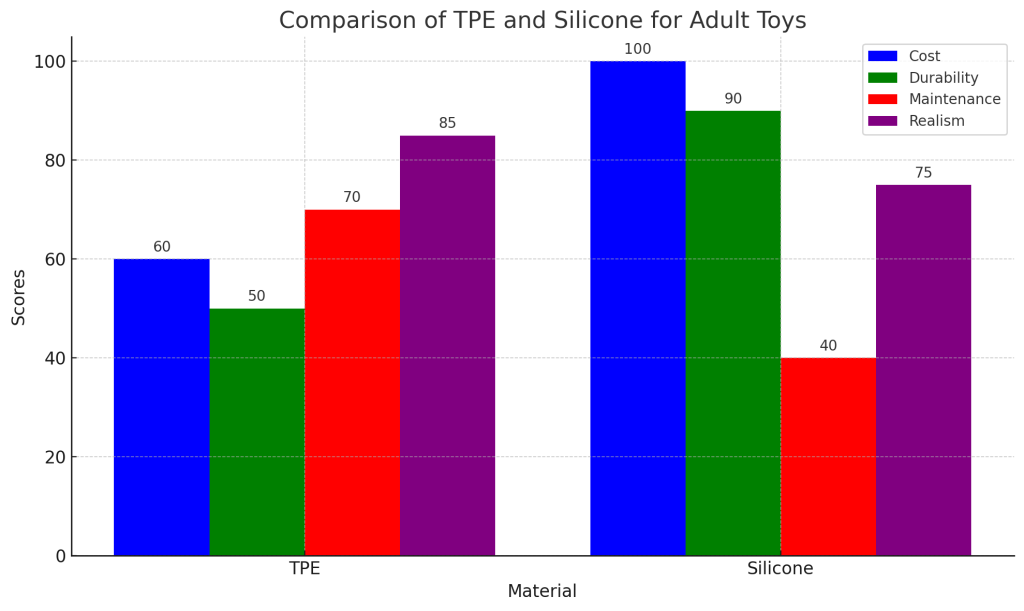
When it comes to adult toys, particularly sex dolls, the choice of material is crucial for both the user experience and the longevity of the product. Two of the most common materials used are Thermoplastic Elastomer (TPE) and silicone. Both have their unique properties and advantages, making them suitable for different preferences and needs. In this article, we’ll explore the differences between TPE and silicone to help you make an informed decision.
Material Composition
TPE (Thermoplastic Elastomer):
- TPE is a blend of plastic and rubber, which makes it highly flexible and soft.
- It’s known for its elasticity, which allows it to mimic the feel of human skin very closely.
- TPE is less expensive to produce, which often makes TPE-based products more affordable.
Silicone:
- Silicone is a synthetic polymer made from silicon, oxygen, and other elements.
- It’s known for its durability, heat resistance, and hypoallergenic properties.
- Silicone is generally more expensive to produce, which reflects in the price of silicone-based products.
Texture and Realism
TPE:
- TPE is highly flexible and stretchy, providing a realistic, soft, and skin-like feel.
- It can easily absorb heat, adding to the realistic sensation during use.
- However, TPE is more porous than silicone, which can make it harder to clean and more prone to bacterial growth if not properly maintained.
Silicone:
- Silicone is less stretchy compared to TPE, but it offers a firmer, more resilient texture.
- It maintains its shape well and doesn’t degrade as quickly over time.
- Silicone is non-porous, making it easier to clean and sterilize, reducing the risk of infections.
Durability and Maintenance
TPE:
- TPE is more susceptible to tearing and damage, especially if not handled with care.
- It requires regular maintenance, including thorough cleaning and powdering to maintain its softness and prevent stickiness.
- TPE can degrade over time, especially if exposed to heat or harsh chemicals.
Silicone:
- Silicone is highly durable and resistant to wear and tear.
- It doesn’t require as much maintenance as TPE, although regular cleaning is still necessary.
- Silicone can withstand higher temperatures and is generally more robust against environmental factors.
Cost
TPE:
- TPE products are usually more affordable, making them a popular choice for first-time buyers or those on a budget.
- The lower cost does not necessarily mean lower quality, but it does reflect in the longevity and maintenance requirements.
Silicone:
- Silicone products are typically more expensive due to the higher cost of materials and production.
- The investment in silicone often pays off in terms of durability, longevity, and lower maintenance needs.
Safety and Allergies
TPE:
- TPE is generally safe and non-toxic, but its porous nature can harbor bacteria if not cleaned properly.
- Users with sensitive skin may need to be cautious, as TPE can sometimes cause irritation.
Silicone:
- Silicone is hypoallergenic and non-porous, making it a safer choice for those with sensitive skin or allergies.
- It is widely used in medical devices, indicating its safety and compatibility with human tissues.
Conclusion
Choosing between TPE and silicone ultimately depends on your personal preferences and priorities. TPE offers a softer, more lifelike feel at a lower cost, but requires more maintenance and is less durable. Silicone, on the other hand, provides superior durability, easier maintenance, and is hypoallergenic, but comes at a higher price.
By understanding the differences between TPE and silicone, you can make an informed decision that best suits your needs and enhances your overall experience with adult toys.

